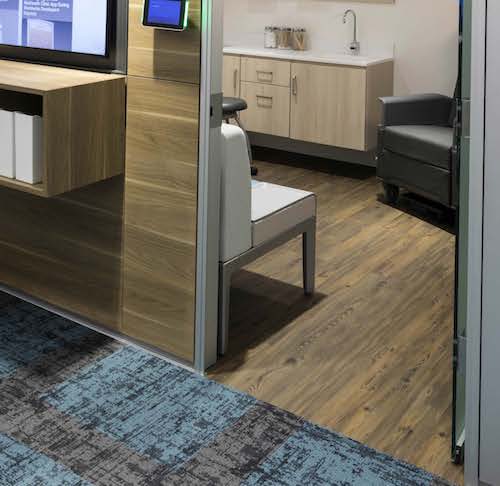
Do you believe that hard surface flooring is better than soft surface flooring in preventing the spread of pathogens like the coronavirus that causes Covid-19?
That’s what many hard surface flooring manufacturers want you to believe, some even going to far as to say avoid soft surface flooring entirely.
But if you follow an evidence-based design process where you make decisions based on the best available evidence, you shouldn’t avoid soft flooring surfaces without first looking at the research on infection control and flooring.
Recommendations and Research
Recently, at the request of my client J+J Flooring and its sister company EF Contract (which both manufacture and sell hard and soft surface flooring) I’ve been digging into recommendations and research on infection control and flooring. Here are seven things I found that you may or may not already know:
- While the transmission of infection is most likely to occur via person-to-person contact, experts say that the role of surfaces in contact transmission should not be ignored.
- The Centers for Disease Control (CDC) categorizes surfaces in healthcare facilities as those with minimal hand contact (floors, ceilings) and high-touch surfaces (furniture, fixtures, beds, equipment, cubicle curtains).
- Research has shown that some hard surface flooring, such as VCT and porcelain tile, harbor higher levels of bacteria than soft flooring surfaces, like carpet, carpet tile, or textile composite flooring.
- While hard surface flooring may be easier to clean than soft surface flooring, researchers have concluded that some types of hard surface flooring may be more difficult to disinfect or sanitize because of their ability to harbor bacteria.
- The CDC says that at least 99.9% of bacteria, viruses, or fungi (pathogens) on a surface can be reduced by sanitizers. A wider range of pathogens can be killed by disinfectants. Cleaners only remove dirt, soils, and impurities from surfaces.
- According to the Carpet and Rug Institute, carpet has an effective “filter-like” or particle trapping feature that tends to trap and hold particles to the floor that would otherwise become airborne. Matter being held can be removed from the environment instead of re-circulating in the air continually by using a high-power vacuum cleaner that has the “CRI Seal of Approval/Green Label (SOA/GL)” certification.
- Research has shown that UVC-equipped commercial vacuum cleaners are effective in reducing microbes on carpet.
What Else About Infection Control and Flooring?
Of course, soft surface flooring isn’t appropriate for all types of healthcare or residential care environments — particularly areas where spills are likely to occur. Another area of concern is seams, which may trap bacteria. But hard surface flooring has seams, too.
And we have yet to know the full effect of heat and humidity on the spread of the coronavirus, but preliminary studies have shown that heat can kill it. Since hot water extraction is a common method of carpet cleaning, this may also provide an additional safeguard.
Another important thing to remember is that pathogens like the coronavirus can be tracked in on shoes. That makes having effective walk-off mats at building entrances even more important no matter what type of flooring surface you have.
Finally, some also may argue that the research on the infection control properties of hard surface vs. soft surface flooring is limited. And that might be true.
But I’d argue that it’s still worth considering.
Sources
For a list of sources for most this information and other insights on flooring and wellness, download the free technical briefs on infection control and indoor air quality on the J+J Flooring and EF Contract websites.
Photo: Courtesy of J+J Flooring
P.S. Please do me a favor — if you liked this post and like this blog, please share it with others by sending them the link or posting it on your Twitter, LinkedIn, or Facebook. Also, don’t forget to subscribe, so you’ll get emails when new content is posted. Thanks!
If you like this post, please share.

What’s my story? I’m a healthcare and senior living design knowledge expert who writes and speaks frequently about trends and issues affecting these two industries. I’m also a strategic marketing consultant and content creator, working with companies and organizations who want to improve the quality of healthcare and senior living through the design of the physical environment. You can reach me at sara@saramarberry.com.


One Response
Years of healthcare architectural practice has convinced me that an impervious PUR ingrained vinyl flooring material with coved skirtings and professionally executed joints remains the best flooring material for hospitals. It has many other advantages.